Three professional leagues begin in a formerly ignored and frequently mocked sport. One has the organizational backing of the sport’s national governing body. The other two rogue upstarts set out to upend the existing order and jockey for pole position in the fastest growing sport in the country.
Ultimate in 2013? No, American soccer in 1967.
Before Major League Soccer became the fourth-most attended sport in America with a media behemoth in its corner and international megastars, soccer found itself embroiled in the same kinds of drama and back-room dealing we are experiencing in the ultimate world today.
Soccer, like ultimate, was a cheap sport, both in equipment and in player salaries. The top clubs in Europe regularly packed their stadiums, and the massive buzz and revenue streams generated by the 1966 World Cup in England – broadcast for the first time in the United States – piqued the interest of several businessmen with aims on becoming America’s first commercially successful professional league.
William Cox, the former owner of baseball’s Philadelphia Phillies, called a press conference on May 10, 1966 to unveil plans for a new 11-team North American Professional Soccer League (NAPSL). Not to be outdone, two rival business owners announced their plans for new leagues shortly thereafter. The North American Soccer League (NASL) was founded by business heavyweight Jack Kent Cooke, owner of the Washington Redskins, Los Angeles Lakers, and Los Angeles Kings, while businessman Richard Millen founded the National Soccer League (NSL).
At the time, the United States Soccer Football Association (USSFA) was a two-person operation with only one full-time worker. Its mission was to govern national teams, promote youth development, and sanction referees and soccer tournaments for most leagues in the US. As a member of the soccer’s international governing organization, FIFA, the USSFA had the sole power in the US to authorize the creation of a new league. If a league was created without USSFA authority, it would be officially considered an “outlaw.” Any player in an outlaw league would subsequently be banned from playing in any other league or team affiliated with the FIFA. As nearly every league and team in the world was affiliated with FIFA, this would effectively ban a player from playing the game anywhere.
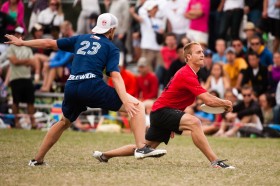
Fans gather to watch the 2012 USA Ultimate Club Championships in Sarasota. (Photo by Jeff Bell – UltiPhotos.com)
Faced with three separate applications for official sanctioning, and a staff of two that was overwhelmed with the amount of attention thrown its way, the USSFA offered their solution: merge to form a single league. The leagues informed the USSFA that a merger would be untenable, while rumors spread about all three being on the verge of negotiating lucrative television deals. In the end, money won the day. The USSFA announced that, in return for its sanction, it required 4% of gate receipts, 10% of any television money, and a $25,000 franchise fee from each club. Cox’s NAPSL and Millen’s NSL summarily refused, citing the fact that one existing professional league was paying only $25 a year for its own professional status. Millen’s NSL subsequently merged with Cox’s NAPSL to form the National Professional Soccer League (NPSL) and announced a gigantic 10-year, $14 million contract with CBS for a national Game of the Week. Cooke’s NASL agreed to the deal, and summarily renamed itself to United Soccer Association (USA) to avoid confusion with its new “outlaw” rivals.
Thus, in the beginning of 1967, after a tremendous amount of backroom dealing, mergers, and backlash from the sport’s governing body, soccer found itself ready to face the world with two newly minted professional leagues (NPSL and USA). The experiences of these leagues in their first several years may shed some light on the challenges and pitfalls that await the AUDL, MLU, NexGen, and to a lesser extent, USA Ultimate’s Triple Crown Tour.
1. Limit Expansion
Over-expansion was a major factor in the death and merger of professional soccer leagues in the 1960s, as the nascent leagues quickly collapsed under their own weight. Both leagues nearly went bankrupt as fan interest, initially high, fell precipitously. In desperation, the leagues merged in 1968, resurrecting the NASL and fielding 17 teams across the country. The average attendance of NASL games peaked at 14,440, despite having the most popular athlete in the world (Pele) as a player. The league hemorrhaged money year after year on account of independently wealthy outsider owners with little ideological interest in keeping the league afloat. Within two months of the first year finals, 12 of the 17 teams folded. Losses from the first season alone ballooned to $6 million for the two leagues due to rental costs for oversized stadiums and outsized salaries.
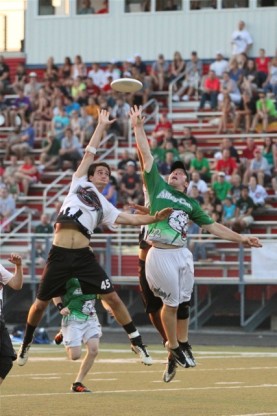
Two AUDL players go up for a disc. (Photo by Lesa Nelson, Pics By Lesa – http://picsbylesa.smugmug.com/AlleyCats2012Season)
The MLS has learned from the lessons of these leagues, implementing financial stability rules such as salary caps and requiring clubs to break even and spend only what they earn from soccer-related income such as ticket sales and broadcast contracts. These rules promote financial parity and consequently competitive parity.
Just like the NASL, the American Ultimate Disc League (AUDL) sought to fill a niche and expand quickly in the ultimate world. The league grabbed attention early with its high-profile signings (Brodie Smith) and audacious stadium plans. Both were plagued by questionable city choices and overly-ambitious expansions. Eyebrows were raised when the AUDL declared its intention to begin its inaugural season with franchises in Buffalo, Hartford, Philadelphia, Providence, Lexington, Columbus, Detroit, and Indianapolis. Philadelphia and Indianapolis each saw games with around 1,000 attendees, but most saw a handful of fans at best. None, save Philadelphia and perhaps Columbus, are cities replete with high-end male ultimate talent and a large community of potential ticket buyers. Only in the second and third years is the league expanding to “traditional” ultimate cities. The league also made the bizarre decision to hold its championship at the Pontiac Silverdome, a decaying stadium with a crowd capacity of over 80,000 where even modest attendance looks impossibly tiny. The Buffalo Hunters, Connecticut Constitution, Philadelphia Spinners, Rhode Island Rampage, and Columbus Cranes no longer exist, and the Bluegrass Revolution have since moved from Lexington to Cincinnati.
Major League Ultimate, on the other hand, has placed teams in locations with strong college feeder programs and thriving local leagues. The choices of Boston, New York, Philadelphia, Washington (Eastern Conference), and Portland, San Francisco, Seattle, Vancouver (Western Conference) not only provide the best pool of talent and investors, but also retain geographic contiguity and limited travel times. Both leagues must be cautious with expansion and not be tempted to overextend themselves in the first several years.
2. Don’t rely on a TV deal for financial stability
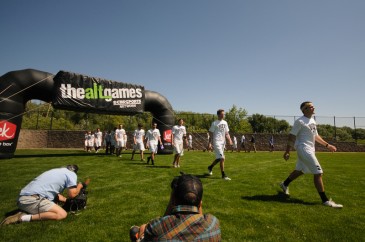
CBS Sports’ Alt Games broadcasted the 2012 College Championships. (Photo by Kevin Leclaire – UltiPhotos.com)
The United Soccer Association had no league-wide television contract, and despite the NPSL’s major television deal with CBS, ratings could not meet minimum standards. The contract was terminated after a single year, citing lack of fan interest or familiarity with the sport. The AUDL, MLU, and NexGen have stated that television broadcasting is less relevant in the age of live streaming and YouTube. USAU’s CBS broadcast of the 2012 College Championship, however, reached 600,000 people and attracted major sponsors compared to several thousand through streaming alone. Streaming reaches a hardcore base of ultimate fans, but USAU’s stated approach of blending broadcast and streaming may prove to be the most enduring model for the future.
3. Be wary of rule changes
For most Americans in the 1960s, soccer was a tough sell, particularly due to its low scoring and perceived lack of action. The NASL modified FIFA’s international rules in an attempt to make the game more exciting, and comprehensible, to the average sports fan. These changes included a countdown clock, altering the rules to limit defensive offside traps, and adding shootouts to decide matches that ended in a draw. Traditional fans decried these changes as a bastardization of the sport they knew and loved.
The AUDL and MLU feature a number of rule changes from the set of rules established and implemented by USAU. The most significant change is the addition of referees who make all calls on the field. The field area was been expanded to 53 1⁄3 yards wide and 80 yards long with 20 yard endzones. Rather than being played to a predetermined score, games are timed with four quarters of 12 minutes each and a 15-minute half time. Contingencies were put in place for two overtime periods, stall counts were dropped to seven, and various yardage penalties were implemented for infractions. Similarly, the MLU has moved from observers to referees and will make numerous other rule changes. The AUDL rule changes have received mixed reviews. If professional ultimate leagues are not careful, they risk alienating traditional ultimate fans while having little to no effect on fans new to the sport.
4. Ownership structure and first-mover advantage matters less than quality of play
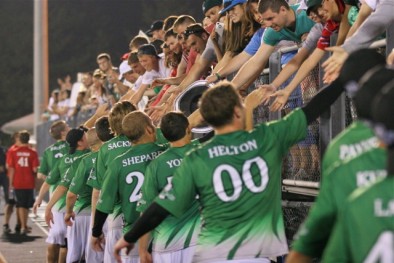
The Indianapolis Alleycats high five fans. (Photo by Lesa Nelson, Pics By Lesa – http://picsbylesa.smugmug.com/AlleyCats2012Season)
The United Soccer Association imported teams and their owners from Europe and South America and appointed a new league commissioner. The NPSL began as a business consortium and sold league shares to investors. The NASL sold franchises to individual owners. All went bankrupt or nearly bankrupt. Professional sports in America operate under a variety of different ownership structures and financial rules. Professional ultimate now has three different ownership models. Whether it’s individual team owners and league ownership (AUDL), team and league shareholders (MLU), or player-led and owned (NexGen), structure matters less than product. Focus on getting the best players on the field and fans in the seats, and the problem will work itself out.
MLU and AUDL soon begin their first and second seasons, respectively. Both off seasons saw a flurry of activity, signing big-players and coaches. NexGen went for a high-risk, high-reward strategy of encouraging elite USAU teams to defect. How professional ultimate looks today may bear little resemblance to the landscape next year, five years from now, or even next week. Before David Beckham signed with the LA Galaxy and the Seattle Sounders began attracting upwards of 40,000 screaming fans per game, professional soccer in the United States was frequently mocked, went through a litany of name changes, and slowly and grudgingly earned the respect of domestic fans. Whatever decision elite teams and players make in the coming weeks, they should remember that the final shakeout is a long time coming.
Don’t get too comfortable, ultimate fans.
Feature photo of NexGen’s Jimmy Mickle pulling the disc. (Photo by Kevin Leclaire – UltiPhotos.com)
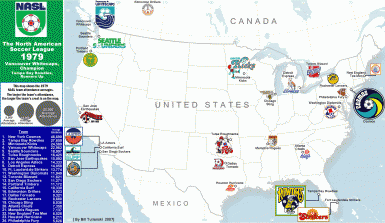






Comments Policy: At Skyd, we value all legitimate contributions to the discussion of ultimate. However, please ensure your input is respectful. Hateful, slanderous, or disrespectful comments will be deleted. For grammatical, factual, and typographic errors, instead of leaving a comment, please e-mail our editors directly at editors [at] skydmagazine.com.